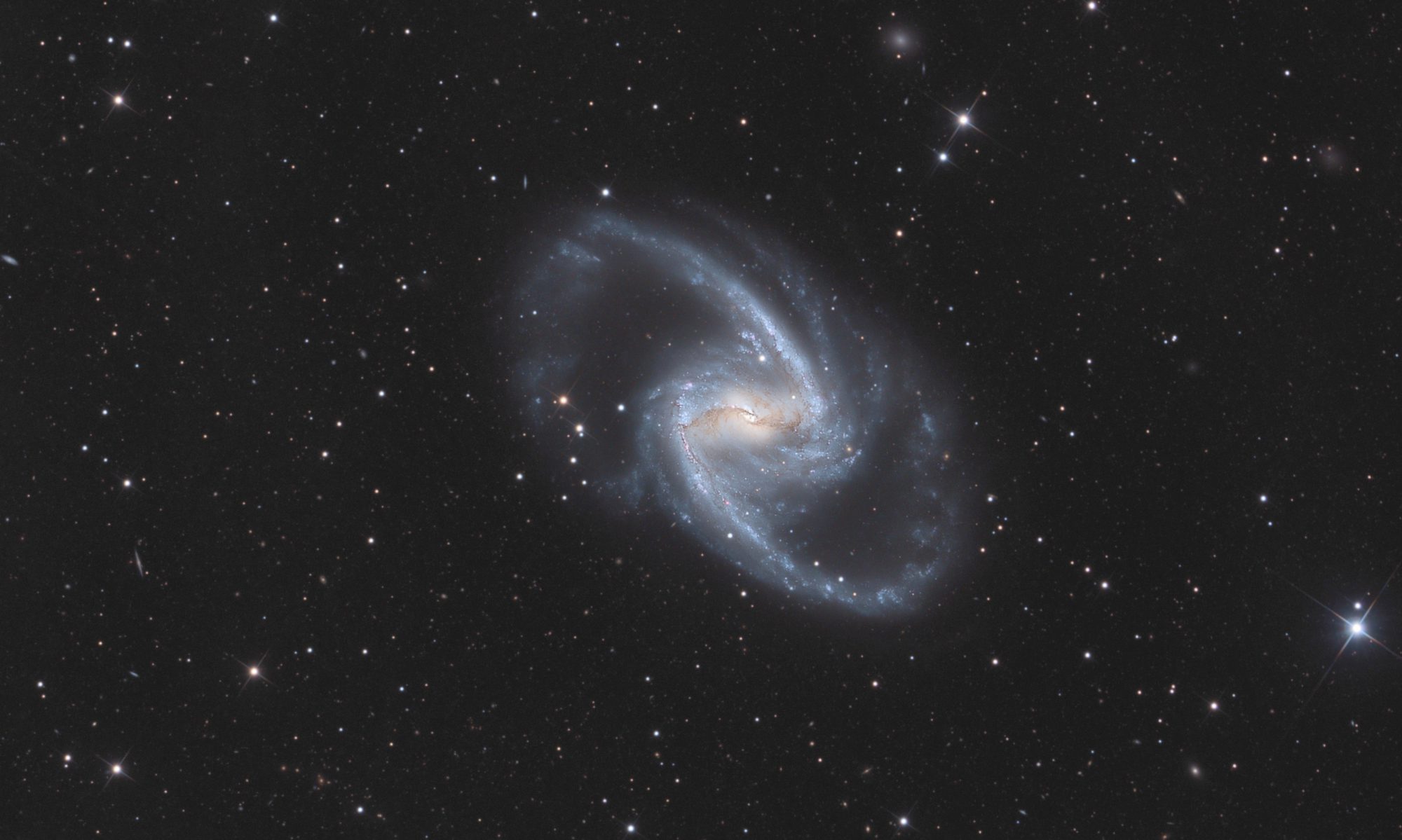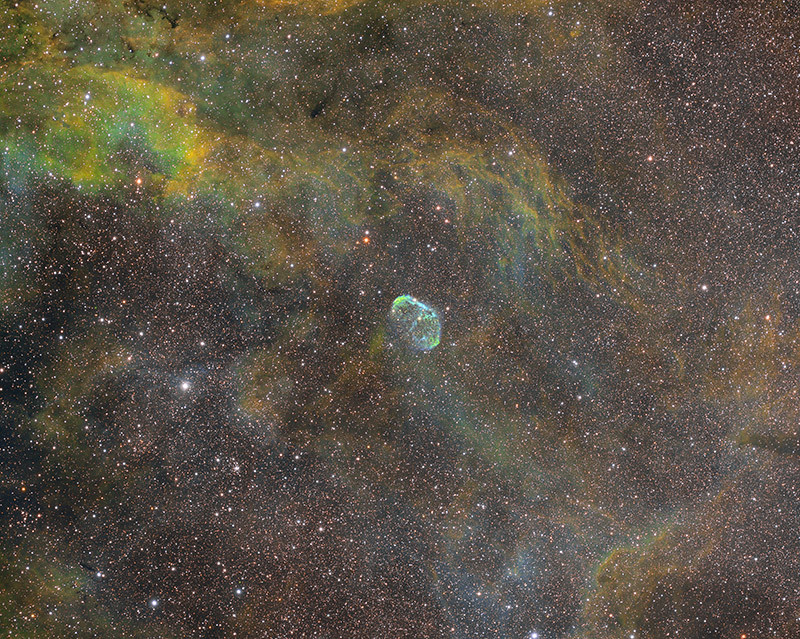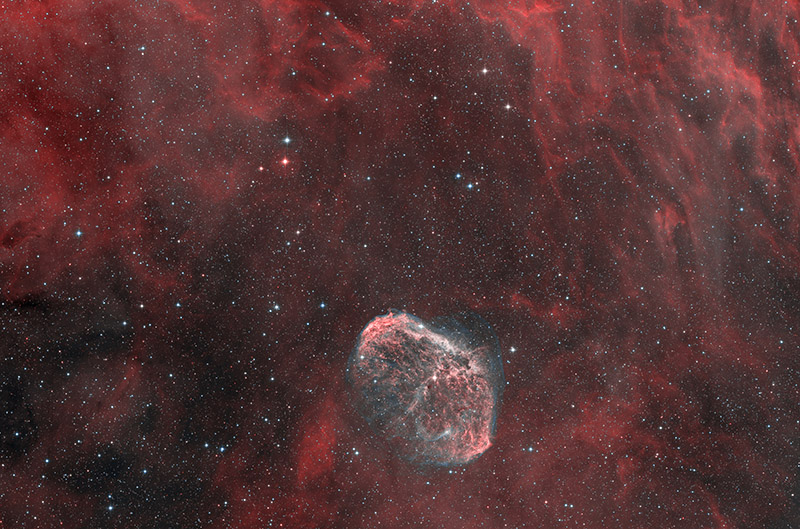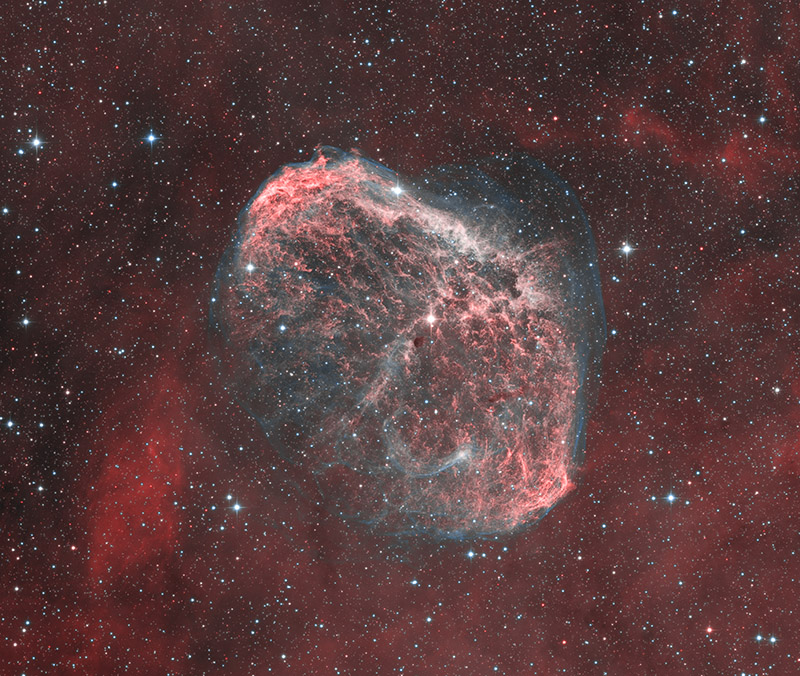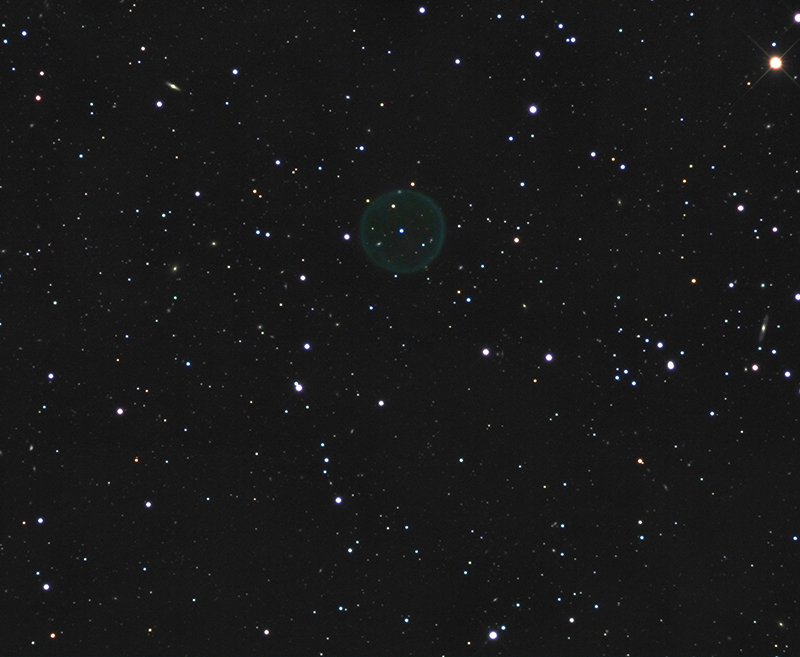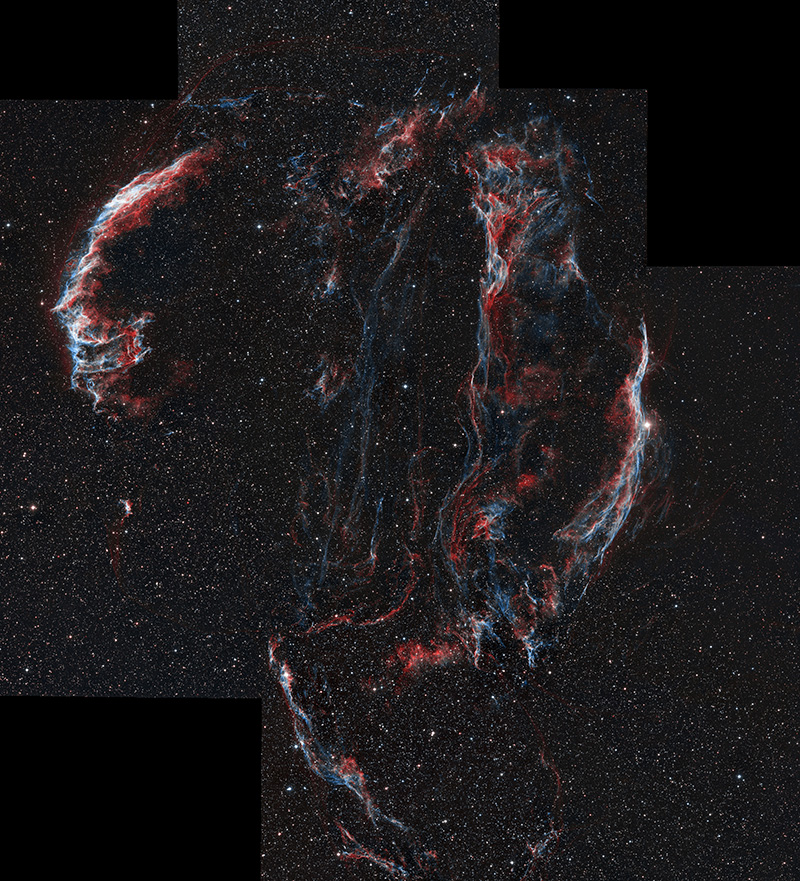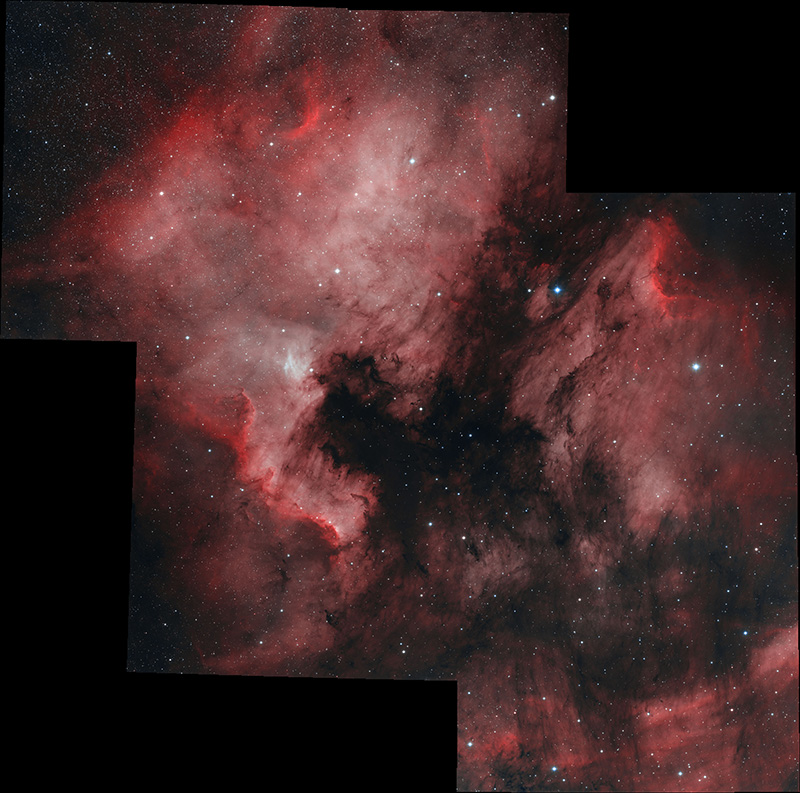IC410
Click on the image to see it full size
IC410 is an emission nebula is located about 12,000 light-years from Earth in the constellation of the Cocher. It contains the open cluster NGC 1893 at its heart.
It is part of a larger star-forming region that also contains the Blazing Star Nebula. The gaseous structures in this image are illuminated by the radiation from the open star cluster NGC1893, which lies at the centre of the nebula. This star cluster is about 4 million years old, but in astronomical terms it is still very young, with hot and massive stars.
At the top left of the star cluster, two denser structures are visible. These are similar to the famous Pillar of Creation and are composed of dust and gas left over from the formation of the star cluster and are very likely to give rise to more stars in the future. As can be seen in the photo, these structures point away from the centre of the nebula. This is due to the stellar winds and radiation pressure from the stars in NGC 1893. Because of the shape of these structures, the nebula is also called the Tadpole Nebula.
.
Technical characteristics: 12h15 exposure in total: SII layer in 3h20. Ha layer in 4h35 and OIII layer in 4h20. Newton-type telescope 500mm diameter F/D=3.
ZWO6200MM-PRO camera
Sampling of 0.52 arcsec per pixel.
Comments on the astrosurf page.
______________________________________________________________________
IC342
Click on the image to see it full size
IC 342 is an intermediate spiral galaxy seen from the front and located in the constellation Giraffe about 11.4 million light-years from the Milky Way. It was discovered by the American astronomer Edward Barnard in 1890. However, as Barnard did not publish this observation, the discovery is attributed to British astronomer William Frederick Denning, who observed this galaxy on 19 August 1892 and published his observation in 1893.
The luminosity class of IC 342 is III-IV and it has a broad HI line. It also contains regions of ionised hydrogen. In addition, it is a galaxy with star-forming bursts.
This galaxy would be much brighter in Earth’s sky if it were not located close to the plane of our galaxy and hidden from our view by clouds of gas and dust.
Based on the galaxy’s internal velocity measured by the Hubble Space Telescope, the mass of the supermassive black hole at the centre of galaxy IC 342 is thought to be between 1.4 and 5.4 million times the mass of the sun.
Technical characteristics: 10h45 exposure in total: 14h25 on the Luminance layer, and 1h15 per Red, Green and Blue colour. Newton-type telescope 500mm diameter F/D=3.
ZWO6200MM-PRO camera
Sampling of 0.52 arcsec per pixel.
Comments on the astrosurf page.
______________________________________________________________________
SH2-115 Abell71
Click on the image to see it full size
Sharpless 115 lies just north and west of Deneb in the constellation Cygnus. It was included in the 1959 SH2 catalogue by astronomer Stewart Sharpless (as Sh2-115),. It is a low-emission nebula that lies along the edge of one of the giant molecular clouds of the outer Milky Way, around 7,500 light-years away. The nebula is fed by hot stars in the Berkeley 90 star cluster. The stars in this cluster are around 100 million years old and are still integrated into Sharpless 115. However, the strong winds and radiation from the stars have erased much of the dusty natal cloud.
SH2-116 or Abell 71 (top right) immediately brings to mind a planetary nebula, but a 1991 study clarified that it is in fact an HII region. It has the typical characteristics of other small H II regions, such as NGC 2359. Its distance is still unknown.
Technical characteristics:
19h50 exposure in total: Ha layer in 11h10 and OIII layer in 8h40 .
Newton-type telescope 500mm diameter F/D=3.
ZWO6200MM-PRO camera
page.
______________________________________________________________________
SH2-131
Click on the image to see it full size
SH2-131 large nebula in the constellation Cepheus.
30h00 exposure in total: SII layer in 10h00. Ha layer in 10h00 and OIII layer in 10h00 . WO RedCat 51 telescope, 51mm diameter. Camera ZWO 1600MM Cool. 10Micron GM2000HPS2 mount.
page.
______________________________________________________________________
SH2-134
Click on the image to see it full size
SH2-134 large nebula in the constellation Cepheus.
30h00 exposure in total: SII layer in 10h00. Ha layer in 10h00 and OIII layer in 10h00 . WO RedCat 51 telescope, 51mm diameter. Camera ZWO 1600MM Cool. 10Micron GM2000HPS2 mount.
page.
______________________________________________________________________
SH2-162
Click on the image to see it full size
SH2-162 large nebula in the constellation Cassiopeia. In the centre, the « Bubble Nebula »
30h00 exposure in total: SII layer in 10h00. Ha layer in 10h00 and OIII layer in 10h00 . WO RedCat 51 telescope, 51mm diameter. Camera ZWO 1600MM Cool. 10Micron GM2000HPS2 mount.
page.
______________________________________________________________________
IC443
Click on the image to see it full size
IC 443, or SNR G189.0+03.0 or Medusa Nebula, is a supernova afterglow located in the constellation Gemini. With a large angular size (45 minutes of arc, or one and a half times the apparent diameter of the Moon), and quite luminous in both X and radio, it is among the most studied supernova afterglows, one reason being that it represents a prototype afterglow interacting with the surrounding interstellar medium. However, neither the distance nor the exact age of the afterglow is known. Optical studies of the expansion of the afterglow suggest a moderate distance (between 2300 and 4600 light-years). IC443 is known to host a neutron star.
Technical specifications:
6h15 exposure in total: Ha layer in 4h15 and OIII layer in 2h00.
Newton-type telescope 500mm diameter F/D=3.
ZWO6200MM-PRO camera
page.
______________________________________________________________________
M33
Click on the image to see it full size
The Triangle Galaxy, also known as M33, is a SA(s)cd-type spiral galaxy belonging to the Local Group and located in the constellation Triangulum. Undoubtedly a satellite of the Andromeda galaxy, its distance from the Sun is fairly poorly known. Current measurements give a distance ranging from about 2.38 millions of a.l. to about 3.07 millions of a.l.
It is the third most massive galaxy in the Local Group after the Andromeda Galaxy and the Milky Way, and ahead of the Large Magellanic Cloud; with an estimated mass of 60 billion solar masses, it represents only 5% of the mass of the Andromeda Galaxy, with dark matter making up nearly 85% of that mass.
First catalogued by Charles Messier in 1764, the Triangulum galaxy had probably been observed before, being visible to the naked eye when conditions were right. Its astronomical study dates back to at least the middle of the XIXth century, since William Parsons, 3th Earl of Rosse, had, as early as 1850, suggested that its structure exhibited spirals.
M33 was used by Gérard de Vaucouleurs as a SA(s)cd morphological type galaxy in his galaxy atlas.
Technical specifications: 10h45 exposure in total: 8h30 on the Luminance layer, and 1h45 per Red, Green and Blue colour. Newton-type telescope 500mm diameter F/D=3.
ZWO6200MM-PRO camera
Sampling of 0.52 arcsec per pixel.
Comments on the astrosurf page.
______________________________________________________________________
SH2-91
Click on the image to see it full size
SH2-91 is a supenovae afterglow located about 2,600 light-years away in the constellation Cygnus.
Technical specifications:
30h00 laying time in total: SII layer in 10h00. Ha layer in 10h00 and OIII layer in 10h00 . WO RedCat 51 51mm diameter refractor. Camera ZWO 1600MM Cool. 10Micron GM2000HPS2 mount.
page.
______________________________________________________________________
NGC2264
Click on the image to see it full size
NGC 2264 is a very young open cluster located in the constellation of the Unicorn. It was discovered by the German-British astronomer William Herschel in 1784. It contains several emission nebulae, reflection nebulae and dark nebulae, including in particular the Cone Nebula.
Technical specifications:
30h00 laying time in total: SII layer in 10h00. Ha layer in 10h00 and OIII layer in 10h00 . WO RedCat 51 51mm diameter refractor. Camera ZWO 1600MM Cool. 10Micron GM2000HPS2 mount.
Comments sur la page astrosurf.
______________________________________________________________________
IC1805 and SH2-199
Click on the image to see it full size
IC 1805 or Heart Nebula (left part of the image), is an emission nebula located about 6,500 light-years away in the constellation Cassiopeia. It covers a field of about 60 arcminutes, which corresponds to approximately 200 light-years.
SH2-199 or Soul Nebula (right part of the image), is an emission nebula located about 6,000 light-years away still in the constellation Cassiopeia.
Technical specifications:
Mosaic of 2 images 30h00 exposure in total: SII layer in 10h00. Ha layer in 10h00 and OIII layer in 10h00 . WO RedCat 51 telescope with 51mm diameter. Camera ZWO 1600MM Cool. 10Micron GM2000HPS2 mount.
page.
______________________________________________________________________
NGC7000 « nebula America » details
Click on the image to see it full size
Nebulae in emission 2000 light years away. They are located in the constellation Cygnus.
Technical characteristics:
22h20 exposure in total: Ha layer in 11h10 and OIII layer in 11h10 . Newton-type telescope 500mm diameter F/D=3. Camera ZWO6200MM-PRO.
Sampling of 0.52 arcsec per pixel.
Comments on the astrosurf page.
______________________________________________________________________
NGC6888
Click on the image to see it full size
Click on the image to see it full size
Click on the image to see it full size
The Crescent Nebula (NGC 6888) is an emission nebula located in the constellation Cygnus, about 5,000 light-years away. It is the result of the fast stellar winds created by the Wolf-Rayet star WR 136, which push the material from slower winds ejected by this same star when it was younger and smaller (red giant type) 400,000 years ago. The shock front creates what is known as a Wolf-Rayet bubble. The nebula is mainly ionised by the central star (photoionisation), which has a surface temperature of 70,000K. The chemical composition of the nebula shows an enrichment in nitrogen and carbon and a depletion in oxygen.
Technical features:
First image:
30h00 laying time in total: SII layer in 10h00. Ha layer in 10h00 and OIII layer in 10h00 . WO RedCat 51 telescope, 51mm diameter. Camera ZWO 1600MM Cool. 10Micron GM2000HPS2 mount.
Second (2×2 binning) and third image (centre of image in 1×1 binning):
20h30 exposure in total: Ha layer in 11h00 and OIII layer in 9h30 . Newton-type telescope 500mm diameter F/D=3. Camera ZWO6200MM-PRO.
Sampling of 0.52 arcsec per pixel.
Comments on the astrosurf page.
______________________________________________________________________
M101
Click on the image to see it in full size
M101, also known as NGC 5457 or Windmill Galaxy, is a spiral galaxy located in the Big Dipper and about 7 Mpc (∼22.8 million al) away. M101 is seen exactly from above but its spiral arms are only visible with large telescopes. The diameter of this galaxy (170,000 light years) is 70% larger than that of the Milky Way (100,000 light years) for a stellar mass of the order of 1,000 billion solar masses, about ten times the mass of our galaxy.
The galaxy was discovered in 1781 by Charles Messier and Pierre Méchain. William Herschel was the first to observe small spots (which were actually fragments of the spiral arms) surrounding the galaxy. Since the beginning of the XXe century, no fewer than four supernovas have been discovered in this galaxy:
- SN 1909A, discovered on by Max Wolf;
- SN 1951H, type II discovered in 1951;
- SN 1970G, discovered on which was the brightest (it reached magnitude 11.5) until the appearance of SN 2011fe;
- SN 2011fe, discovered on reaches magnitude 10 on , probably close to its maximum.
Technical specifications: 13h20 exposure in total: 9h20 on the Luminance layer, and 1h20 per Red, Green and Blue colour. Newton-type telescope 500mm diameter F/D=3.
ZWO6200MM-PRO camera
Sampling of 0.52 arcsec per pixel.
Comments on the astrosurf page.
______________________________________________________________________
NGC4145 and NGC4151
Click on the image to see it full size
NGC 4145 is a barred spiral galaxy (top galaxy) located in the Ursa Major galaxy cluster, 68 million light-years from Earth. The galaxy has little star formation, except at its outer edges. Due to the loss of energy that occurs without star formation, some astronomers predict that the galaxy will degenerate into a lenticular galaxy in the near future. However, the galaxy’s interaction with NGC 4151 may « maintain its star formation. »
NGC 4151 (bottom galaxy) is an intermediate spiral galaxy located about 19 Mpc (∼62 million a.l.) from Earth in the constellation Hounds. The galaxy was first mentioned by William Herschel on 17 March 1787.
It is one of the closest galaxies to Earth to contain a growing supermassive black hole. Its nucleus is thought to contain a binary black hole of between 10 million and 40 million solar masses orbiting over a period of 15.8 years.
Some astronomers believe that it is a supermassive black hole.
Some astronomers have nicknamed this galaxy the « Eye of Sauron » because of its peculiar shape.
Technical characteristics:
9h05 exposure in total: 5h20 on the Luminance layer, and 1h15 per Red, Green and Blue colour. Newton-type telescope 500mm diameter F/D=3.
ZWO6200MM-PRO camera
Sampling of 0.52 arcsec per pixel.
Comments on the astrosurf page.
______________________________________________________________________
IC443 and SH2-249
Click on the image to see it full size
IC 443, or SNR G189.0+03.0 or Medusa Nebula (right part of the image), is a supernova afterglow located in the constellation Gemini. With a large angular size (45 minutes of arc, or one and a half times the apparent diameter of the Moon), and quite bright in both X and radio, it is among the most studied supernova afterglows, one reason being that it represents a prototype afterglow interacting with the surrounding interstellar medium. However, neither the distance nor the exact age of the afterglow is known. The study of the expansion of the afterglow in optics argues for a moderate distance (between 2300 and 4600 light-years), but its probable association with the structure called SH2-249 suggests a greater distance (4600 to 6500 light-years). IC443 is known to host a neutron star.
SH2-249 (left part of the image) is an emission nebula, emitting mainly into the Ha.
Technical specifications:
30h00 laying time in total: SII layer in 10h00. Ha layer in 10h00 and OIII layer in 10h00 . WO RedCat 51 51mm diameter refractor. Camera ZWO 1600MM Cool. 10Micron GM2000HPS2 mount.
page.
______________________________________________________________________
NGC4631 and NGC4656
Click on the image to see it full size
NGC4631 (top galaxy) or whale glaxy, is a spiral galaxy seen from the edge. It is about 25 to 30 million light-years from Earth in the constellation Hounds.
It is located close to NGC 4627 and NGC 4621, with which it is gravitationally interacting.
NGC 4631 contains a star-forming burst region, which is a region in which there is a high rate of star formation. Star formation is evident from the emissions of hydrogen ions and interstellar medium given off by the forming stars. The magnetic field observed in NGC 4631 exhibits large-scale features discovered in 2019 and still unexplained.
NGC4656 or Hockey Stick Galaxy (bottom galaxy), is a galaxy located about 25 million light-years from Earth in the Hound Dog constellation.
Technical characteristics:
9h05 exposure time in total: 6h35 on the Luminance layer, and 50min per Red, Green and Blue colour. Newton-type telescope with 500mm diameter F/D=3. Sampling of 0.52 arcsec per pixel.
Comments on the astrosurf page.
______________________________________________________________________
NGC7822
Click on the image to see it full size
NGC 7822 is a nebula located about 3,000 light-years from Earth, in the constellation Cepheus. A few tens of light years across, the region includes the astronomical objects Sharpless 171 and the young star cluster Berkeley 59.
The nebula is also home to one of the hottest stars near the Sun, BD+66 1673, a binary system including an O5V with a surface temperature of around 45,000 kelvins and a luminosity around 100,000 times that of the Sun.
Technical specifications:
30h00 laying time in total: SII layer in 10h00. Ha layer in 10h00 and OIII layer in 10h00 . WO RedCat 51 51mm diameter refractor. Camera ZWO 1600MM Cool. 10Micron GM2000HPS2 mount.
page.
______________________________________________________________________
NGC7008
Click on the image to see it full size
NGC7008 also known as the Foetus Nebula, is a colourful planetary nebula located at a distance of about 869 parsecs (∼2,830 light-years) in the constellation Cygnus.
Technical specifications:
11h05 exposure in total: 7h20 on the Luminance layer, and 1h15 per Red, Green and Blue colour. Location: Pierre Antonini Observatory. RC telescope with a diameter of 400mm F/D=9. Sampling of 0.5 arcsec per pixel.
Comments on the astrosurf page.
______________________________________________________________________
NGC7662
Click on the image to see it full size
NGC7662, nicknamed the Blue Snowball (Blue snowball in English), is a remarkable planetary nebula located 5600 light-years away. Its gaseous envelope, almost a light-year in diameter, has a magnitude of 9.20, while its central star, with a temperature in excess of 75,000 K, has a magnitude of 12.50.
.
Technical characteristics:
12h30 exposure in total: 8h00 on the Luminance layer, and 1h30 per Red, Green and Blue colour. Location: Pierre Antonini Observatory. RC type telescope with a diameter of 400mm F/D=9. Sampling of 0.5 arcsec per pixel.
Comments on the astrosurf page.
______________________________________________________________________
Abell39
Click on the image to see it full size
Abell39 is an almost perfectly spherical planetary nebula located in the constellation of Hercules. A faint nebula, its distance is estimated at around 6,800 light-years from Earth and 4,600 light-years from the galactic plane. With a radius of around 2.5 light-years, it is one of the largest known planetary nebulae. Despite its almost uniform spherical shell, the eastern edge of the nebula is 50% brighter than the western edge. This asymmetry could be linked to the star’s off-centre position. Other luminous irregularities can be seen on the surface of the shell. Its central star is located slightly west of the centre of the nebula, 2 arcseconds (0.1 light-years). This position does not appear to be due to an interaction with the interstellar medium but rather to a hypothetical asymmetry during the mass ejection at the time of the star’s death, which would have accelerated and off-centre the star from the nebula.
Technical specifications:
12h45 exposure in total: 8h45 on the Luminance layer, and 1h20 per Red, Green and Blue colour. Location: Pierre Antonini Observatory. RC type telescope with a diameter of 400mm F/D=9. Sampling of 0.5 arcsec per pixel.
Comments on the astrosurf page.
______________________________________________________________________
LBN347
Click on the image to see it full size
LBN347 is a nebula in the constellation Cygnus. It is a structure quite similar to a supernova remnant, but no supernova remnants have been found in this region. Its complex, steamy structure is more likely the result of winds generated by hot, massive stars interacting with the magnetic fields of the interstellar medium.
Top left is a planetary nebula that goes by the name KN26. This planetary nebula has a rather rare characteristic, it has 4 poles. You can find explanations of KN26 on this page:
https://arxiv.org/pdf/1301.3149.pdf
Technical specifications:
17h40 exposure in total: 12h00 on the Ha layer, and 5h40 in OIII. Newton-type telescope of 500mm diameter F/D=3. Sampling of 1.2 arcsec per pixel.
Comments on the astrosurf page.
______________________________________________________________________
HFG1 and Abell6
Click on the images to see them full size
HFG1 ( = PK 136+05) and Abell 6 (PK 136+4.1) form a unique pair of planetary nebulae in the constellation Cassiopeia.
HFG1 takes its name from its three discoverers: Heckathorn, Fesen and Gull. Its central star V664 Cas, mag. 14.5 is a precataclysmic tight binary.
A publication suggests that HFG1 leaves behind a gas tail emitting in the Ha and NII wave logs. This tail, which is at least 20′ long, extends north-westwards and is thought to be around 10,000 years old. HFG1 itself has an interesting structure, with an arc on the opposite side of the tail, i.e. in the direction of motion of the nebula, suggesting that it is a shock wave front of matter interacting with the interstellar medium. We also note three brighter lobes in the OIII line and a fainter central zone where the Ha signal dominates.
Abell 6 is a classic example of a bubble in this catalogue (type 2b), but also remains fairly faint (mag=15.0), with stronger OIII emission than in Ha. Nevertheless, its structure shows some irregularities, in particular two thin lobes at the eastern and western edges. Its dimensions are 188×174″
.
Technical characteristics:
33h00 exposure in total: 17h00 on the Ha layer, and 16h00 in OIII. Newton-type telescope of 500mm diameter F/D=3. Sampling of 1.2 arcsec per pixel.
______________________________________________________________________
LBN576
Click on the image to see it full size
LBN576 is the afterglow of a supervova in the constellation Cassiopeia. It is also found under the names CTB 1 or Abell 85.
Technical characteristics:
Ha in 13h00mn. OIII in 11h20mn
24h20 exposure in total: 13h00 on the Ha layer, and 11h20 in OIII. Newton-type telescope 500mm diameter F/D=3. Sampling of 1.2 arcsec per pixel.
Comments on the astrosurf page.
______________________________________________________________________
NGC4565
Click on the image to see it full size
Galaxy seen from the edge in the constellation of Berenice’s Hair at a distance between 31 and 40 million light-years.
Technical specifications:
8h00 exposure in total: 5h00 on the Luminance layer, and 1h per Red, Green and Blue colour. Newton-type telescope with 500mm diameter F/D=3. Sampling of 0.52 arcsec per pixel.
______________________________________________________________________
NGC650 or Messier76
Click on the image to see it full size
Planetary nebula in the constellation Perseus with an estimated distance of between 1700 and 15000 light years.
Technical characteristics:
13h20 exposure in total: 10h20 on the Luminance layer, and 1h per Red, Green and Blue colour. Newton-type telescope with 500mm diameter F/D=3. Sampling of 0.52 arcsec per pixel.
______________________________________________________________________
NGC7331
Click on the image to see it full size
Galaxy in the constellation Pegasus 42 light years away.
Technical specifications:
9h30 exposure in total: 6h30 on the Luminance layer, and 1h per Red, Green and Blue colour. Newton-type telescope with 500mm diameter F/D=3. Sampling of 0.52 arcsec per pixel.
______________________________________________________________________
NGC6992, NGC6995 and NGC6960: « the laces of the Swan »
Click on the image to see it full size
The Laces of the Swan are the remains, 1440 light-years away, of a supernova whose explosion is thought to have occurred around ten thousand years ago. They are located in the constellation Cygnus.
Technical characteristics:
Mosaic of 8 images, with on each image, 2h exposure in Ha and 2h in OIII. Newton-type telescope with 500mm diameter F/D=3. Sampling of 1.2 arcsec per pixel.
Comments on the astrosurf page.
______________________________________________________________________
NGC7000, IC5067 and IC5070: « North America and Pelican nebulae »
Click on the image to see it full size
Nebulae in emission 2000 light years away. They are located in the constellation Cygnus.
Technical characteristics:
Mosaic of 5 images, with on each image, 2h exposure in Ha and 2h in OIII. Newton-type telescope with 500mm diameter F/D=3. Sampling of 1.2 arcsec per pixel.
Comments on the astrosurf page.
<
